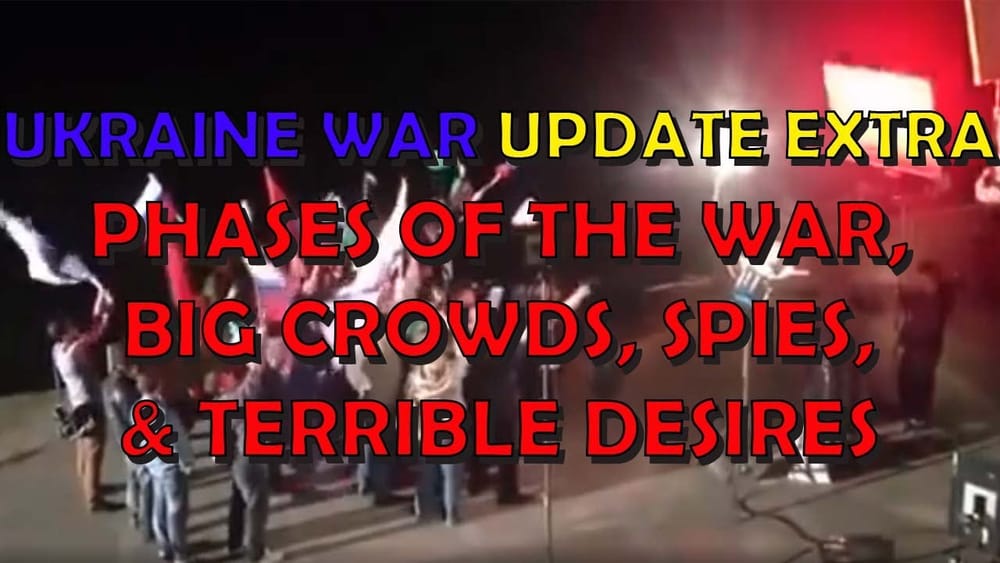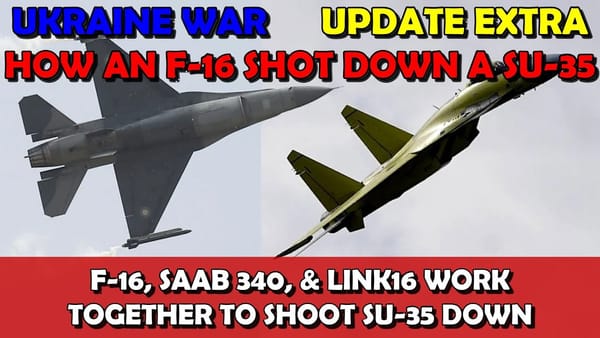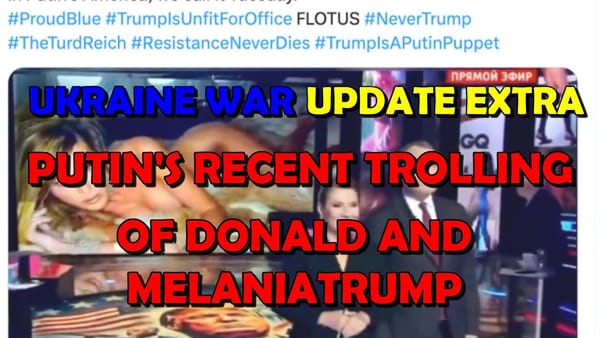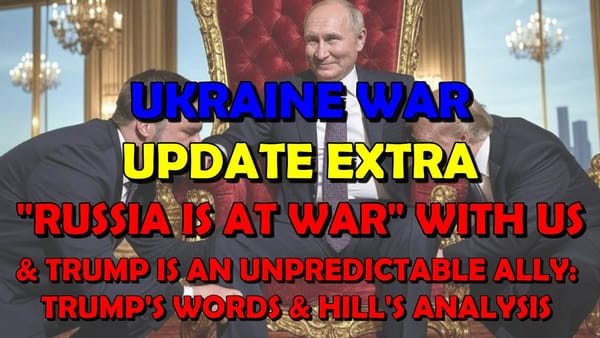Ukraine War Upd. EXTRA: Phases of the War, Big Crowds, Speis, & Terrible Desires
Table of Contents 📖
"I think the Ukraine are in the best position they've been during this war right now...Not, well, not as in right now with what they've got now, but in terms of where they're going."
Hello Team
🎦 00:00-00:40⏩
Jonathan introduces the "Ukraine War Update Extra" video, focusing on providing additional insights into the ongoing conflict. He highlights an article in "War on the Rocks" by Neil Hoyer titled "Ukraine’s War of Narratives," which examines the shifting perceptions and narratives surrounding the war.
Return to top⤴️
Seven Narrative Phases of the War
🎦 00:40-08:31⏩
Jonathan discusses Neil Hoyer's article, which identifies seven distinct narrative phases of the war, each marked by swings in public and media perception.
- Phase 1 (Pre-War): Widespread expectation of a swift Russian victory.
- Phase 2 (Early War): Ukrainian resilience challenges initial assumptions, leading to a belief in potential Ukrainian victory.
- Phase 3 (Donbas Focus): Russia concentrates on the Donbas region, leveraging its artillery superiority and fuelling perceptions of Russia's inevitable victory due to its size and resources.
- Phase 4 (Ukrainian Counteroffensive): Ukraine launches successful counteroffensives, liberating territories and creating a sense of imminent Russian collapse, fuelled by mobilisation protests and fleeing citizens. Optimism rises for a swift Ukrainian victory.
- Phase 5 (Stalemate & Bakhmut): Ukraine's momentum stalls due to ammunition shortages and the arrival of mobilised Russian troops. The prolonged and costly siege of Bakhmut reinforces pessimism about Ukraine's prospects.
- Phase 6 (Counteroffensive Build-Up): Ukraine and Western partners prepare for a counteroffensive, training new brigades and raising expectations of significant territorial gains, possibly even reaching Crimea.
- Phase 7 (Counteroffensive Disappoints & Pessimism Returns): Ukraine's counteroffensive fails to meet expectations due to strong Russian defences, leading to renewed pessimism and discussions about fading Western support and the inevitability of negotiations.
Jonathan observes a recurring pattern where periods of pessimism regarding Ukraine's chances are followed by periods where Ukraine's position is demonstrably stronger than during the previous low point. He posits that each "trough" is less dire than the one preceding it, even though public perception tends to forget this cyclical pattern.
Return to top⤴️
Current State & Western Aid
🎦 08:31-15:42⏩
Jonathan argues that despite the current narrative focusing on the counteroffensive's shortcomings, Ukraine is in its strongest position yet. They possess better equipment and have secured more sustainable supply lines for ammunition and weaponry from Europe and other partners. The main challenges are the lack of boots on the ground and the current hold-up of US aid. He believes these are solvable problems and that the situation is not as dire as some perceive it to be.
Return to top⤴️
Propaganda and Manufactured Crowds
🎦 15:42-19:58⏩
Jonathan shows a video from 2014 of a seemingly large pro-Russian rally in Sevastopol, Crimea. He points out a second video revealing the "crowd" to be a small group of individuals strategically positioned for the camera. He highlights the prevalence of this tactic, used by various political groups globally, to create an illusion of widespread support and popularity.
Return to top⤴️
The Spy Who Drank Himself to Death
🎦 19:58-24:01⏩
Jonathan shares a Twitter anecdote from a former Estonian intelligence officer about a colleague who defected to Russia. This colleague, considered a friend, later denounced the officer as a CIA agent during a press conference in Moscow. After Estonia gained independence, the defector was found dead, having apparently drunk himself to death. Jonathan finds this story illustrative of the complex and often morally ambiguous nature of espionage and the personal betrayals involved. He expresses his own aversion to lying and deception, stating that he would make a terrible spy.
Return to top⤴️
Russian Soldier's Disturbing Motivations
🎦 24:01-28:19⏩
Jonathan presents a video of a Russian man explaining his motivations for joining the army. The man's reasons are deeply disturbing: he relishes the idea of killing Ukrainians without consequence and expresses a desire to torture and mutilate captured soldiers, believing his actions to be morally justified. Jonathan is shocked by the man's words, highlighting the dangers of dehumanising propaganda and the perversion of morality.
Return to top⤴️
Chinese Volunteer's Rude Awakening
🎦 28:19-34:18⏩
Jonathan shows two videos of a Chinese man who volunteered to fight for Russia. The first video depicts him enthusiastically joining his comrades, while the second shows him in a distressed state, suffering from illness and lack of medical care. He expresses regret for his decision, claiming he was misled by propaganda. Jonathan points out the stark contrast between the man's initial enthusiasm and his current despair, highlighting the harsh realities of war that are often concealed by propaganda. He also questions the legal implications of the man's situation, having signed a contract with the Russian army.
Return to top⤴️
Advocating for Ukraine
🎦 34:18-35:20⏩
Jonathan encourages viewers to advocate for increased support for Ukraine, regardless of their political affiliations. He displays a letter written by a Republican voter to their congressman as an example and suggests using similar content to contact their own representatives.
Return to top⤴️
Wrap up
🎦 35:20-37:40⏩
Jonathan concludes by thanking his supporters on platforms like Buy Me a Coffee and PayPal, acknowledging their generosity. He briefly mentions his plans to discuss the role of hacking in the war in a future video.
Return to top⤴️



